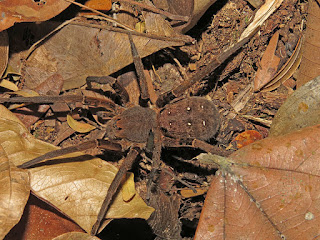August 19,
2015
Our punctual
flight yesterday arrived in Alta Floresta with great views of the city below.
This was one of the first areas of the vast Amazonian rainforest that fell to
government incentives to settle in the 1970’s. Intact rainforest is still only
a short drive away, fortunately.
We had an
afternoon to bird around the grounds of the Floresta Amazonica Hotel very close
to the airport, but the pair of Harpy Eagles that nested in the forest fragment
here at least three times since 2005 seem to have moved on. As I did for my
last group, I quickly found an antlion larva. Despite its being so abundant and
widespread, with nearly everyone familiar with the pitfall traps they make,
surprisingly few people have actually seen the actual animal.
A late
evening attempt to bring in a Great Potoo that I heard just before dinner behind
the hotel turned in to a short walk down the forest trail to look for scorpions
with my scorpion light. Finally, I spotted this tiny thick-tailed scorpion,
resembling Tityus silvestris in its
speckled appearance, but lacking other field marks and most certainly not that
species.
We also saw a
Crested Owl and this ctenid spider, related to the highly venomous wandering
spiders.
This morning
we birded our way to Cristalino Jungle Lodge before lunch, stopping for the
Red-bellied Macaw show at the usual buritizal
– a grove of Mauritia flexuosa palms
on the road north. We then made a couple stops on the road through Cristalino’s
forest patch on the west side of the Teles Pires river. One of our first birds
was rather a surprise, this Rose-breasted Chat singing just a couple feet above
the ground in a thicket of dry weeds and vines right next to the road. I’d only
ever seen them in dense, green vine tangles, difficult to see overhead on dark
forest trails.
Our last bit
of birding before lunch was done from the boat as we crossed to the east side
of the Teles Pires River and then up the Cristalino. This Capped Heron posed
nicely for photos, unlike on my last tour.
We also had
this Gray-necked Wood-Rail, boldly foraging in broad daylight (which they do
commonly in the Pantanal, but no so much here).
We got lucky
with this pair of Lutra longicaudis,
Neotropical River Otters, one crunching on a bony armored catfish (plecostomus
to pisciculturists).
Arriving at
the lodge, I was pleased to see that my efforts to maintain a puddle party
during the last tour were still effective – Statira, Straight-lined, Apricot,
and Orange-barred Sulphurs.
Upon
arrival, the head of hospitality gives the group an orientation talk while they
enjoy a welcome drink of a local fruit juice.
In the
afternoon we took a relaxing boat on the river downstream.
We watched sunset
on the Teles Pires before stopping on shore for a very cooperative
Tawny-bellied Screech-Owl and heading upstream with spotlights to look for
nightlife on the banks of the Cristalino, where we spotted a Great Potoo.
Back at the
lodge, all the guests were fascinated with this line of Eciton burchellii, Swarming Army Ants , crossing the trail between
the rooms and the common area. We weren’t certain exactly what was going on,
why so many of the ants had dedicated themselves to making a barricade on
either side of what would normally be a single file line of ants relocating the
colony. My guess is that they perceived the well-swept portion of the trail a
dangerous crossing of sorts.
Meanwhile at
the moth sheet…
I had
written the lodge management about the possibility of putting up a moth sheet
in a better location (open to the sky on one side rather than deep in the
forest on a trail), and using a brighter light with shorter wavelengths, rather
than the dim fluorescent bulb they had earlier in the month. As it turns out,
Edson Endrigo had arrived with a group he was guiding with exactly such a
light, and with my suggestion they relocated the sheet at the edge of the
clearing with the majority of the guest rooms. It worked like a charm, and
there were as many moths tonight as there were during my entire week earlier in
the month.
This big
sphinx moth is the recognizable Pachylia darceta.
This is a Megalopyge sp., one of those flannel
moths with caterpillars you shouldn’t touch.
I’d like to
think that some day there will be a field guide to all these pretty little pyraloid
moths.
There are a
lot more photos available online of arctiine moths, so this one I was able to
identify as Trichromia atta.
This is also
an arctiine moth, Uranophora walkeri.
This one I
recognized as an Acraga sp., family
Dalceridae. The caterpillars of these are rarely seen jewels, looking like
colorful collections of transparent glass beads.

























No comments:
Post a Comment